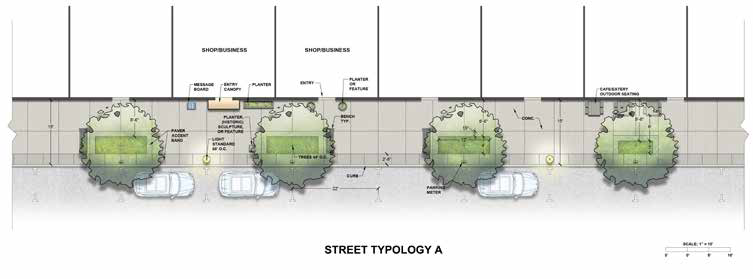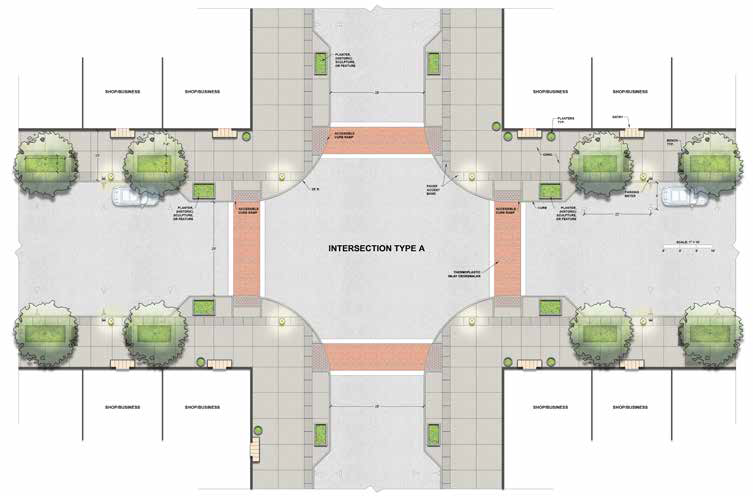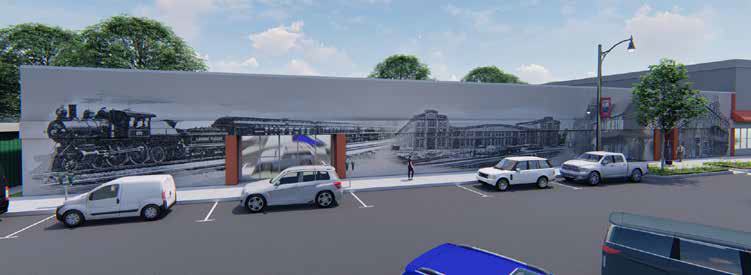It was critical to understand the existing vehicular traffic within and around the downtown. Through the assessment, it was determined that most of the traffic entering the borough does not currently pass through the downtown, which is counterproductive to creating an active district. To make visitors aware of downtown Sayre and its amenities, re-routing primary vehicular circulation is proposed.
The proposed vehicular arrival experience to downtown Sayre utilizes Lehigh Avenue as the main vehicular approach to downtown Sayre. Lehigh draws visitors directly onto Desmond Street and encourages interaction with downtown merchants and amenities. To clearly demarcate this road as the primary approach, physical improvements to the streetscape are proposed such as signage, street trees, sidewalks, and designated crossings. In addition, and to further indicate the primary access to town, a physical gateway is proposed for the corner of Allison and Lehigh.

Walkable communities are normally characterized by having a range of services and amenities within a 10–15-minute walk of residential neighborhoods
and places of employment. To improve the walkability of the borough and enhance the quality of life for its community, additional pedestrian and trail connections were studied and proposed. Building upon existing trails like the Diahoga, new trail links are proposed connecting to Athens and S. Waverly Boroughs along Lehigh Avenue. The Borough should expand the walkable nature of the municipality and provide better connections to surrounding communities and existing amenities.
Design guidelines for street enhancements were created to provide strong and safe pedestrian zones in the downtown and enhance the character of the district. Material choices were derived from community input related to pedestrian improvements. Three standard streetscape typologies define walkway hierarchy, and two typical intersection treatments provide safer pedestrian crossings and contribute to the enhanced aesthetic of downtown Sayre.
At primary intersections, curb bump-outs can be added to enhance safe pedestrian crossings. Crosswalk improvements consisting of thermoplastic inlay systems mimic materials such as brick to improve the visual quality of intersections and enhance the brand of downtown Sayre.
In addition, an analysis was completed of potential open space available for large outdoor events to be in an area with highest impact to the community. The location was determined to be Howard Elmer Park. By temporarily closing Elmer Avenue, the lawn can be used for seating. With minimal impact, this could provide enough space for community gathering. To tie into the park, the Theatre lot is proposed as a splash pad/family play area with flexible seating opportunities on S. Elmer Avenue.




To improve the look and feel of the downtown streetscape, Sayre could provide incentives and design standards to help building owners upgrade existing architecture by:
• Improving paint/ finishes
• Permitting blade signs with lighting
• Improving windows and doors
• Enhancing wall materials
• Enhancing storefronts/awnings
• Revising roofs/cornices
• Adding lighting
• Adding artwork such as murals
It is recommended that the borough re-evaluate some of their ordinance language related to facades to allow for the community preferred aesthetics such as projecting signs.
Results of the character preference studies identified murals as a preferred way to enhance the downtown. The the mural graphic, below, was created as a suggestion for highlighting the history of downtown Sayre.
Results from the parking study indicated that parking strategies should be simplified to encourage visitors to park downtown and support the current and future housing and retail market growth. Over the course of the next several years, a series of phased, 90 day testing periods are suggested to improve public parking in the downtown.
